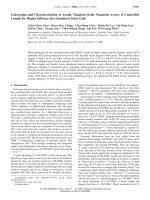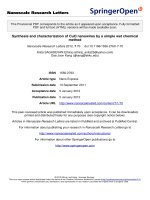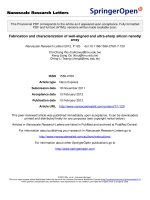Fabrication and characterization of supercapacitor electrode by 3D printing
Bạn đang xem bản rút gọn của tài liệu. Xem và tải ngay bản đầy đủ của tài liệu tại đây (685.73 KB, 8 trang )
Vietnam Journal of Science and Technology 56 (5) (2018) 574-581
DOI: 10.15625/2525-2518/56/5/10978
FABRICATION AND CHARACTERIZATION OF
SUPERCAPACITOR ELECTRODE BY 3D PRINTING
Hoang Tran Dung1, *, Ngo Thanh Dung1, Trinh Quang Dung1,
Doan Thanh Tung1, 2, Nguyen Thi Yen1, Le Thi Thanh Tam2, Tran Viet Thu3,
Phan Ngoc Hong2, 4, Le Trong Lu1, 2, *
1
Institute for Tropical Technology, VAST, 18 Hoang Quoc Viet, Cau Giay, Ha Noi
2
Graduate University of Science and Technology, VAST, 18 Hoang Quoc Viet, Cau Giay, Ha Noi
3
Le Quy Don Technical University, 236 Hoang Quoc Viet, Bac Tu Liem, Ha Noi
4
Center for high technology development, VAST, 18 Hoang Quoc Viet, Cau Giay, Ha Noi
*
Email: ; ;
Received: 13 December 2017; Accepted for publication: 1 September 2018
Abstract. 3D printing technology has emerged as a unique platform for rapid prototyping of
various applications at low cost. Herein, we present a study on the fabrication and
characterization of supercapacitor electrode by 3D printing. A colloidal suspension containing
carbon nanotubes (CNTs) and cobalt ferrite nanoparticles (CoFe2O4 NPs) was used as ink. The
ink was successfully printed on nickel foam and graphite paper substrates using a modified 3D
printer followed by solvent evaporation to form a porous CNTs/CoFe2O4 aerogel film. The
characterization results show that the film has porous surface, high electrical conductivity and
good electrochemical properties, indicating its promising application as supercapacitor electrode
for energy conversion and storage.
Keywords: 3D printing, electrode, supercapacitor, hybrid nanomaterials.
Classification numbers: 2.4.4; 2.8.2
1. INTRODUCTION
The economic and social development of modern society is increasingly dependent on
energy supply, which makes energy conversion and storage becoming important. Batteries are
widely used in industrial applications because of their high energy density. In recent years,
supercapacitors have attracted much interest due to their superior properties such as short
charge/discharge time, high power density and long life [1-4]. However, the energy density of
commercially available supercapacitors is still lower than that of traditional batteries.
Supercapacitors have a specific energy density of 5-80 Wh/kg (energy density ≤ 10 Wh/kg with
commercial products), much smaller than traditional batteries are widely used in the market
(about 170 Wh/kg). Therefore, the size of supercapacitor is higher than that of rechargeable
Fabrication and characterization of supercapacitor electrode by 3d printing
batteries at the same energy level [3, 4]. In order to improve the energy density of
supercapacitors, most researches are now focused on the development of new electrode materials
that will yield better performances [2].
The charge is stored in supercapacitor in the form of electrochemical double layers or
electrochemical energy. To be used as supercapacitor electrode, a material must have high
specific surface area and high electrical conductivity. Low-cost and abundant carbon-based
materials such as activated carbon and graphite meet these requirements, and have been widely
used in commercially available supercapacitors [2, 5]. Recently, it was reported that carbon
materials of nanoscale such as carbon nanotubes (CNTs) and graphene exhibited superior
performance as compared to activated carbon or graphite. However, carbon-based materials only
store charge in the form of electrochemical double layer. To provide additional electrochemical
energy (faradaic pseudocapacitance), various metal oxides such as nickel oxide (NiO),
ruthenium dioxide (RuO2), manganese oxide (MnO2), iridium oxide (IrO2) have been used to due
to their high pseudocapacitance and electrochemical stability. The combination of a carbon
material with a metal oxide may offer enhanced properties as compared to lone ones, because
both physical and chemical charge storage mechanism are provided in a single electrode [2].
Moreover, novel phenomena such as synergic effects can be observed, which greatly improve
electrode performance [2]. Recently, rational designs of supercapacitor electrodes based on
hybrids of CNTs and metal ferrites/oxides have been reported [6-10].
In addition to material design, the development of large-scale manufacturing techniques for
fabrication of supercapacitors is critical for realizing their practical applications. Recently, 3D
printing, or additive manufacturing (AM) [11, 12], has been emerging as promising solution for
future manufacturing. The powerful capacity of 3D printing for rapid prototyping makes it a
unique but ubiquitous platform for a vast range of applications, from mechanical engineering,
medicine, to materials science. Notably, 3D printing technologies renovates the manufacturing
as a whole, from design to fabrication, at a significantly lower cost [12].
In this study, we investigate the possibility of fabricating supercapacitor electrodes using
3D printer and colloidal ink made of CNTs and CoFe2O4 nanoparticles (NPs). The 3D printer
was built by modifying commercially available 3D printer so that it is compatible with
CNTs/CoFe2O4 NPs nanohybrid ink. The printed film was characterized using various
techniques to assess its suitability for supercapacitor electrode.
2. MATERIALS AND METHODS
2.1. Design and fabrication of printer for colloidal ink
The printer for printing electrode was designed based on robocasting technology or direct
ink writing [12] to utilize the simplicity and low cost of the method. The overall structure of the
printing system is shown in Fig. 1, which consists of three parts. Software part consists of some
required PC-based softwares which are used to design objects, generate G-code and send them to
electronic part. Electronic part gets commands and controls the mechanical part to perform
necessary tasks to print the designed objects.
The moving bed style is applied to the mechanical part. Moving bed-style printer moves the
print bed as one of the axes (Y-axis). The print head mounted on the ZX gantry is moved in the
Z-axis. This is a mechanically simpler design in which the X-axis and Y-axis are managed
independently using entirely linear motion. The mechanical structures of the printer were
designed using SolidWorks, a 3D design software. Materials for this design were chosen from
575
Hoang Tran Dung et al.
commercial components available on the market. The parameters are selected to match these
components to make advantages in design and fabrication. The NEMA 17 two phase stepper
motors with A4988 stepper motor controller modules are chosen to drive the motion of the axes
and the extruder. An Arduino Mega 2560 board and a RAMPS module are the most common
and useful electronic components for 3D printer. A smart controller which contains a SD-card
reader, a rotary encoder and a LCD display can be added to the printer. The mechanical parts
needed to build the printer include a 20 20 aluminum profile, linear motion shafts, linear ball
bearings, lead screws and nuts, and GT2 pulleys and belts. All support parts were designed in
SolidWorks and printed by a commercial 3D printer. The firmware was configured and modified
from the free Repetier firmware to be suitable with this printer. Repetier-Host software was used
to give full control of the printer, slicer and printing process if needed.
Figure 1. The overall structure of the printing system.
2.2. Fabrication of porous CNTs/CoFe2O4 aerogel film
The CNTs/CoFe2O4 aerogel film was fabricated using freeze gelation method [13]. CNTs
were synthesized using chemical vapor deposition method by the Laboratory of Carbon
Nanomaterials [14]. CoFe2O4 NPs were synthesized by thermal decomposition of organometallic
precursors of corresponding metals (Fe (III) and Co (II) acetylacetone) in octadecene using oleic
acid/oleylamine as surfactant and 1,2-hexadecanediol as accelerating agent [15]. Then the
surfactant of NPs was replaced by nitrosonium tetrafluoroborate (NOBF4) by ligand exchange
reaction [16]. The weight ratio of CoFe2O4 NPs over CNTs was kept at 2 %. Typically, 76 mg
powder mixture of CNTs and CoFe2O4 NPs and 4 mg of poly (vinyl alcohol) (PVA) were mixed
in 2 mL of phenol in liquid form at 60 oC for 30 minutes, using sonication to form a stable
dispersion. The suspension was then filled in the print head to be used as ink. A designed pattern
was printed on the substrates (nickel foam or graphite paper) to form electrodes with the process
shown in Figure 2. Firstly, a designed sample of 20 10 0.8 (all dimensions are in mm) was
printed on the substrates (nickel foam and graphite paper) to form electrodes. The
CNTs/CoFe2O4 ink was filled in the print head. Then the print-head was controlled to extrude
the ink onto the substrate. The printed electrodes were then cooled down in an ice bath until the
solidification of phenol was completed. The electrode was taken out and stored at room
condition. The CNTs/CoFe2O4 aerogel film on the substrate was obtained when the sublimation
process of phenol was completed. The printed electrodes are denoted as CNT-NP-GP (printed on
576
Fabrication and characterization of supercapacitor electrode by 3d printing
graphite paper) and CNT-NP-NF (printed on nickel foam). Besides, a sample denoted as CNTGP was also printed on graphite paper with the CNTs ink (without CoFe2O4 NPs).
Figure 2. The process of printing supercapacitor electrodes.
2.3. Analytical methods
The morphology of CNTs and printed CNTs/CoFe2O4 aerogel film were observed by
scanning electron microscopy (SEM, Hitachi S-4800 microscope) and transmission electron
microscopy (TEM, Jeol JEM-1010 microscope). Electrochemical property of the printed
CNTs/CoFe2O4 aerogel film was characterized by cyclic voltammetry (CV) method in 0.1 M
tetraethylammonium tetrafluoroborate (TEABF4, Sigma Aldrich) in acetonitrile (Xilong
Scientific) using a Bio-Logic VSP-300. A platinum rod was used as counter electrode. Ag/AgCl
in saturated KCl as a reference electrode and working electrode was CNTs/CoFe2O4 aerogel film
printed on graphite paper substrate.
3. RESULTS AND DISCUSSION
3.1. The assembled printer for colloidal ink
The printer was completely assembled and calibrated in order to achieve a good printing
quality. The printer was assembled easily from parts and can be applied for printing electrode as
shown in Fig. 3. The main specifications of the printer are Travel range: 190 190 120 (all
dimensions are in mm); Control: Repetier - Host, Smart controller; Print materials:
577
Hoang Tran Dung et al.
CNTs/CoFe2O4 NPs colloidal ink.
Figure 3. The perspective design (left) and real image of assembled printer (right).
3.2. Morphology of the printed electrodes
Figure 4. SEM image of CNTs (a) and TEM image of CoFe2O4 NPs (b).
The SEM image of CNTs (Fig. 4(a)) shows that all CNTs are in the form of long tube,
indicating their good electrical conductivity. TEM image of CoFe2O4 NPs (Fig. 4(b)) shows that
CoFe2O4 NPs are in uniformly spherical shape with an average diameter of ca. 10 nm. Figure 5
shows SEM images of CNT-NP-GP (a, c) and CNT-NP-NF (b, d). In comparison with CNTs
(Fig. 4(a)), the morphology of CNTs before and after printing is well preserved. The
morphology of single CoFe2O4 NPs is not well observed due to the limited resolution of the
scanning electron microscope we used. However, the formation of aggregated nanoparticles on
CNTs in various shapes (mainly, spheres) can be evidenced on the CNTs/CoFe2O4 hybrid film.
Due to the sublimation of phenol, the film becomes more porous, which is beneficial for the
diffusion of electrolytes during charge/discharge of the printed electrode. From Fig. 5, it is
realized that the obtained film has not got the uniform distribution of CoFe2O4 NPs on CNTs.
The morphology and distribution of CoFe2O4 NPs on CNTs in the obtained film can affect on
the electrochemical properties of electrode and it will be discussed in the next section.
578
Fabrication and characterization of supercapacitor electrode by 3d printing
Figure 5. SEM images of CNT-NP-GP (a, c) and CNT-NP-NF (b, d) at different magnifications.
3.3. Electrochemical property of the printed electrode
Figure 6 shows the CV curves of CNT-GP (a) and CNT-NP-GP (b) at a scan rate of 50
mV/s with 200 cycles. The calculated specific capacitances at the third cycle of CNT-NP-GP
and CNT-GP in the potential range from -1.0 V to 1.5 V are 13.9 F/g and 5.0 F/g, respectively.
This result shows that adding nanoparticles can increase the performance of the electrode. It is
possible that the porosity of the CNTs film was changed after adding nanoparticles. The
formation of aggregated nanoparticles on CNTs made them split apart instead of being stacked
together as without nanoparticles. Thus, the surface area of the electrode is increased leading to
enhance specific capacitance as the result of CV test. In addition, ferrite NPs are materials
storing charge based on pseudocapacitance mechanism, the presence of the materials in the
CNT-NP composite is also the reason for the improvement of the capacitance.
The stability of the working electrodes is evaluated by the reduction of the specific
capacitances according to numbers of cycles of CV tested. After 200 cycles, the specific
capacitance of CNT-NP-GP retained 88.6 % of the initial value, while the specific capacitance
of CNT-GP is also mantained at 86.4% of the original value (as shown in Fig. 7). The obtained
values indicate that both samples are relatively high electrochemical stability and they are
potential for supercapacitor electrodes. With relatively high stability and wide potential window,
the printed electrodes are capable of applying for supercapacitor. However, specific capacitances
need improving further by optimizing various parameters during printing process, as well as ink
formulation.
579
Hoang Tran Dung et al.
Figure 6. CV curves of CNT-GP (a) and CNT-NP-GP (b).
Figure 7. Cycle stability of CNT-GP and CNT-NP-GP during 200 CV cycles at 50 mV/s. Specific
capacitance vs. cycle number (a) and Capacitance retention vs. cycle number (b).
4. CONCLUSIONS
A printer for printing colloidal suspension has been designed and assembled successfully
with available components and open source software. It can be used to fabricate supercapacitor
electrode by printing hybrid materials on different substrates. The initial specific capacitance of
CNTs/CoFe2O4 hybrid electrode was 13.9 F/g. The hybrid nanomaterials used as ink for this
printer need to be improved to get higher performance electrode to widely apply for the
fabrication of supercapacitors.
Acknowledgements. The authors are grateful for the finance supports for this work by ITT (2017 annual
project), VAST (VAST03.05/17-18 project) and NAFOSTED (grant number 103.02-2015.100).
REFERENCES
1.
Halper M. S., Ellenbogen J. C. - Supercapacitors: a brief overview, The MITRE
Corporation, McLean, Virginia, Technical report 06-0667, Mar 2006.
2.
Zaharaddeen S. Iro, C. Subramani, Das S. S. - A Brief Review on Electrode Materials for
Supercapacitor, Int. J. Electrochem. Sci. 11 (2016) 10628 - 10643.
580
Fabrication and characterization of supercapacitor electrode by 3d printing
3.
Patrice Simon and Yury Gogotsi - Materials for electrochemical capacitors, Nature
Materials 7 (2008) 845 – 854.
4.
Guoping Wang, Lei Zhang and Jiujun Zhang - A review of electrode materials for
electrochemical supercapacitors, Chem. Soc. Rev. 41 (2012) 797–828.
5.
Elzbieta Frackowiak, François Béguin - Carbon materials for the electrochemical storage
of energy in capacitors, Carbon 39 (2001) 937–950.
6.
Jong Hyeok Park, Jang Myoun Ko, and O. Ok Park - Carbon Nanotube/RuO2
Nanocomposite Electrodes for Supercapacitors, J. Electrochem. Soc. 150 (7) (2003)
A864-A867.
7.
Po-Chiang Chen, Guozhen Shen, Saowalak Sukcharoenchoke, and Chongwu Zhou Flexible and transparent supercapacitor based on In2O3 nanowire/carbon nanotube
heterogeneous films, Appl. Phys. Lett. 94 (2009) 043113.
8.
Zheng Chen, Veronica Augustyn, Jing Wen, Yuewei Zhang, Meiqing Shen, Bruce Dunn,
and Yunfeng Lu - High-Performance Supercapacitors Based on Intertwined CNT/V2O5
Nanowire Nanocomposites, Adv. Mater. 23 (2011) 791-795.
9.
Aravinda L.S., Nagaraja K.K., Nagaraja H.S., Udaya Bhat K., Ramachandra Bhat B. ZnO/carbon nanotube nanocomposite for high energy density supercapacitors,
Electrochim. Acta. 95 (2013) 119-124.
10. Lin P., She Q., Hong B., Liu X., Shi Y., Shi Z., Zheng M., and Dong Q. - The Nickel
Oxide/CNT Composites with High Capacitance for Supercapacitor, J. Electrochem. Soc.
157 (7) (2010) A818-A823.
11. Sharon L. N. Ford - Additive Manufacturing Technology: Potential Implications for U.S.
Manufacturing Competitiveness, Journal of International Commerce & Economics,
September 2014.
12. Adriano Ambrosi and Martin Pumera - 3D-printing technologies for electrochemical
applications, Chem. Soc. Rev. 45 (2016) 2740-2755.
13. Yue Lin, Fei Liu, Gabriel Casano, Rupesh Bhavsar, Ian A. Kinloch, and Brian Derby Pristine Graphene Aerogels by Room-Temperature Freeze Gelation, Adv. Mater. 28 (36)
(2016) 7993-8000.
14. Nguyen Van Chuc, Nguyen Duc Dung, Phan Ngoc Hong, Le Dinh Quang, Phan Hong
Khoi and Phan Ngoc Minh - Synthesis of Carbon Nanotubes on Steel Foils, Journal of the
Korean Physical Society 52 (5) (2008) 1368-1371.
15. Le T. Lu, Ngo T. Dung, Le D. Tung, Cao T. Thanh, Ong K. Quy, Nguyen V. Chuc,
Shinya Maenosonoe and Nguyen T. K. Thanh - Synthesis of magnetic cobalt ferrite
nanoparticles with controlled morphology, monodispersity and composition: the influence
of solvent, surfactant, reductant and synthetic conditions, Nanoscale 7 (46) (2015) 19596–
19610.
16. Angang Dong, Xingchen Ye, Jun Chen, Yijin Kang, Thomas Gordon, James M. Kikkawa
and Christopher B. Murray - A generalized ligand-exchange strategy enabling sequential
surface functionalization of colloidal nanocrystals, J. Am. Chem. Soc. 133 (4) (2011) 9981006.
581









